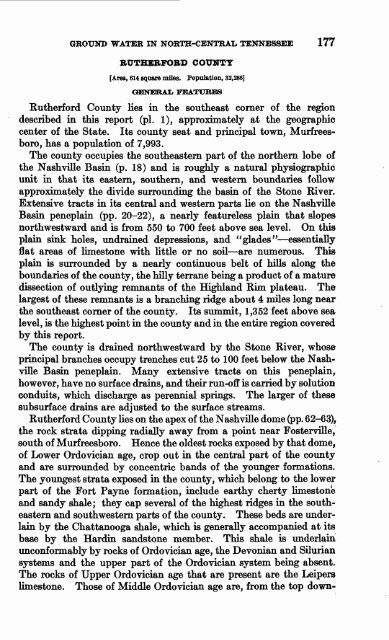GROUND WATER IN NORTH-CENTRAL TENNESSEE
GROUND WATER IN NORTH-CENTRAL TENNESSEE
GROUND WATER IN NORTH-CENTRAL TENNESSEE
You also want an ePaper? Increase the reach of your titles
YUMPU automatically turns print PDFs into web optimized ePapers that Google loves.
<strong>GROUND</strong> WATEB <strong>IN</strong> <strong>NORTH</strong>-CENTRA!, <strong>TENNESSEE</strong> 177<br />
RUTHERFORD COUNTY<br />
[Area, 614 square miles. Population, 32,286]<br />
GENERAL FEATURES<br />
Rutherford County lies in the southeast corner of the region<br />
described in this report (pi. 1), approximately at the geographic<br />
center of the State. Its county seat and principal town, Murfrees-<br />
boro, has a population of 7,993.<br />
The county occupies the southeastern part of the northern lobe of<br />
the Nashville Basin (p. 18) and is roughly a natural physiographic<br />
unit in that its eastern, southern, and western boundaries follow<br />
approximately the divide surrounding the basin of the Stone River.<br />
Extensive tracts in its central and western parts lie on the Nashville<br />
Basin peneplain (pp. 20-22), a nearly featureless plain that slopes<br />
northwestward and is from 550 to 700 feet above sea level. On this<br />
plain sink holes, undrained depressions, and "glades" essentially<br />
flat areas of limestone with little or no soil are numerous. This<br />
plain is surrounded by a nearly continuous belt of hills along the<br />
boundaries of the county, the hilly terrane being a product of a mature<br />
dissection of outlying remnants of the Highland Rim plateau. The<br />
largest of these remnants is a branching ridge about 4 miles long near<br />
the southeast corner of the county. Its summit, 1,352 feet above sea<br />
level, is the highest point in the county and in the entire region covered<br />
by this report.<br />
The county is drained northwestward by the Stone River, whose<br />
principal branches occupy trenches cut 25 to 100 feet below the Nash<br />
ville Basin peneplain. Many extensive tracts on this peneplain,<br />
however, have no surface drains, and their run-off is carried by solution<br />
conduits, which discharge as perennial springs. The larger of these<br />
subsurface drains are adjusted to the surface streams.<br />
Rutherford County lies on the apex of the Nashville dome (pp. 62-63),<br />
the rock strata dipping radially away from a point near Fosterville,<br />
south of Murfreesboro. Hence the oldest rocks exposed by that dome,<br />
of Lower Ordovician age, crop out in the central part of the county<br />
and are surrounded by concentric bands of the younger formations.<br />
The youngest strata exposed in the county, which belong to the lower<br />
part of the Fort Payne formation, include earthy cherty limestone<br />
and sandy shale; they cap several of the highest ridges in the south<br />
eastern and southwestern parts of the county. These beds are under<br />
lain by the Chattanooga shale, which is generally accompanied at its<br />
base by the Hardin sandstone member. This shale is underlain<br />
unconformably by rocks of Ordovician age, the Devonian and Silurian<br />
systems and the upper part of the Ordovician system being absent.<br />
The rocks of Upper Ordovician age that are present are the Leipers<br />
limestone. Those of Middle Ordovician age are, from the top down-

















